Nursing Practice: Concept Analysis of Patient Satisfaction
VerifiedAdded on 2023/01/18
|13
|3705
|82
Report
AI Summary
This report provides a comprehensive concept analysis of patient satisfaction within the nursing profession, utilizing Walker & Avant's method to dissect the multifaceted aspects of patient experience and perceptions of care. It begins by establishing the significance of patient satisfaction as a key indicator of healthcare quality and explores the factors influencing patient expectations and evaluations. The analysis progresses through eight stages, including defining the concept, identifying attributes, and examining model, related, and contrary cases to illustrate the nuances of patient satisfaction. The report highlights the impact of nurse-patient interactions, work environments, and the overall healthcare setting on patient satisfaction levels. It also examines the attributes contributing to lower patient satisfaction, such as poor hospital environments, inadequate nurse staffing, and weak interpersonal relationships. Through detailed case studies, the report offers practical insights into enhancing patient satisfaction and improving the quality of nursing care.
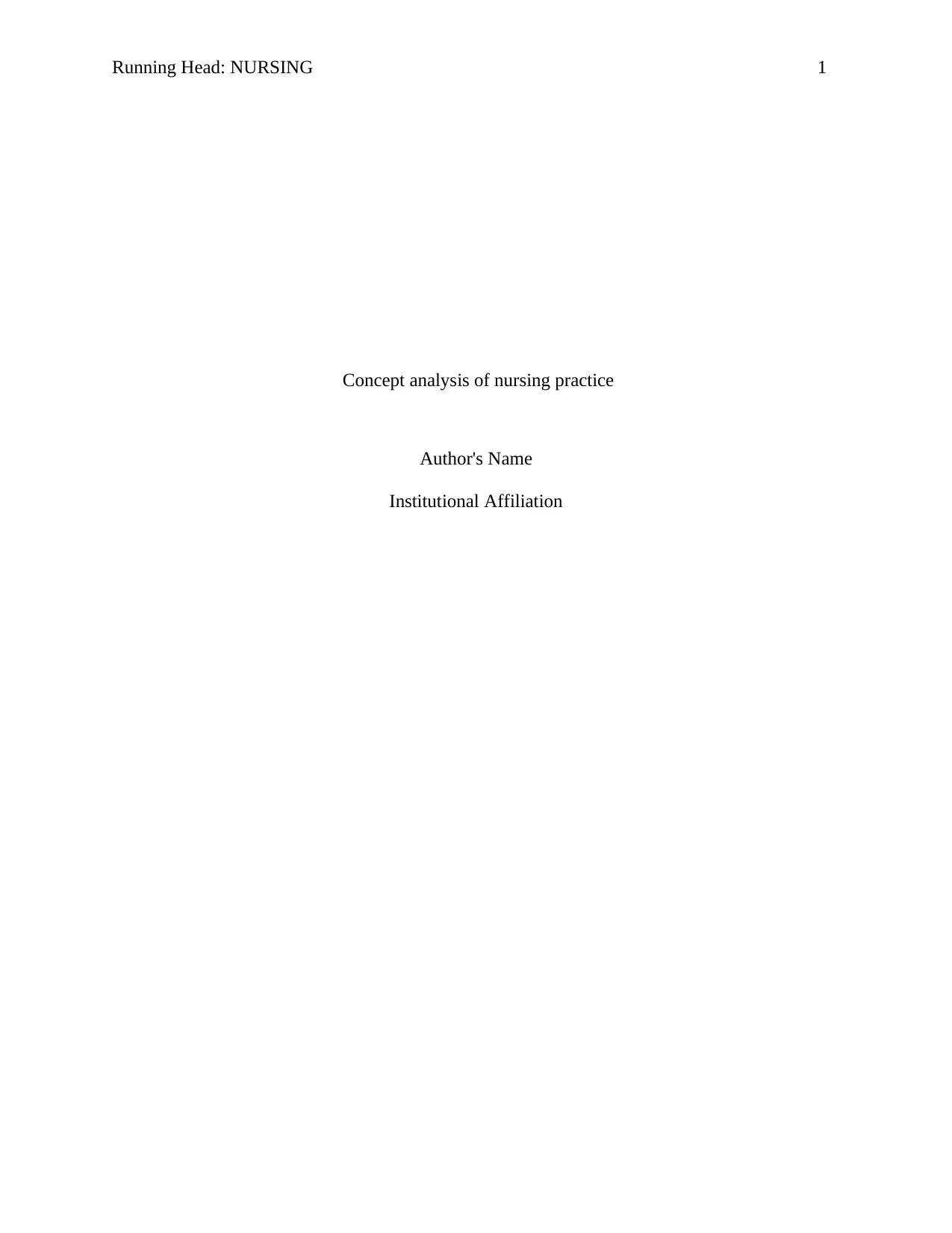
Running Head: NURSING 1
Concept analysis of nursing practice
Author's Name
Institutional Affiliation
Concept analysis of nursing practice
Author's Name
Institutional Affiliation
Paraphrase This Document
Need a fresh take? Get an instant paraphrase of this document with our AI Paraphraser

NURSING 2
Introduction
The concept of patient experience and satisfaction holds significant importance in the
nursing profession and healthcare industry. What the patient experiences become a measure for
his satisfaction and the perception of the quality of nursing care. It is how the patient feels about
receiving nursing care that impacts his perceptions. The paper makes a concept analysis of the
concept of patient satisfaction based on Walker & Avant’s approach and investigates as to how
well the research literature addresses the concept. The analysis provides comprehension of
different components that work behind a patient’s experience and satisfaction with the nursing
care in the health care industry.
Walker & Avant’s method performs concept analysis in eight phases: selecting a concept,
determine the aim of analysis, identify the use of the concept, define attributes, identify a model
case, related, and contrary cases, detect backgrounds and consequences, and define experiential
referents (Yazdani, Hosseini, & Ahmady, 2016). Walker and Avant, the nursing scientists, look
at concept analysis to be an excellent way to examine information that forms the basis of any
research or theory. Concept analysis is an activity where concepts as parts of the whole, their
characteristics, and the relations within systems get are explained and described as stated by
Nuopponen (2010). Concept analysis makes a careful examination and explains how the final
product is always cautious despite the precise process of concept analysis. The concepts carry a
dynamic nature and can be changed because of the cultural, social, and contextual factors in
different fields, as asserted by Yazdani, Hosseini, & Ahmady (2016). The technique of Walker
and Avant is used to make the concept analysis of patient satisfaction in nursing services. Each
of the eight stages will be discussed as part of the concept analysis of satisfaction of a patient and
Introduction
The concept of patient experience and satisfaction holds significant importance in the
nursing profession and healthcare industry. What the patient experiences become a measure for
his satisfaction and the perception of the quality of nursing care. It is how the patient feels about
receiving nursing care that impacts his perceptions. The paper makes a concept analysis of the
concept of patient satisfaction based on Walker & Avant’s approach and investigates as to how
well the research literature addresses the concept. The analysis provides comprehension of
different components that work behind a patient’s experience and satisfaction with the nursing
care in the health care industry.
Walker & Avant’s method performs concept analysis in eight phases: selecting a concept,
determine the aim of analysis, identify the use of the concept, define attributes, identify a model
case, related, and contrary cases, detect backgrounds and consequences, and define experiential
referents (Yazdani, Hosseini, & Ahmady, 2016). Walker and Avant, the nursing scientists, look
at concept analysis to be an excellent way to examine information that forms the basis of any
research or theory. Concept analysis is an activity where concepts as parts of the whole, their
characteristics, and the relations within systems get are explained and described as stated by
Nuopponen (2010). Concept analysis makes a careful examination and explains how the final
product is always cautious despite the precise process of concept analysis. The concepts carry a
dynamic nature and can be changed because of the cultural, social, and contextual factors in
different fields, as asserted by Yazdani, Hosseini, & Ahmady (2016). The technique of Walker
and Avant is used to make the concept analysis of patient satisfaction in nursing services. Each
of the eight stages will be discussed as part of the concept analysis of satisfaction of a patient and
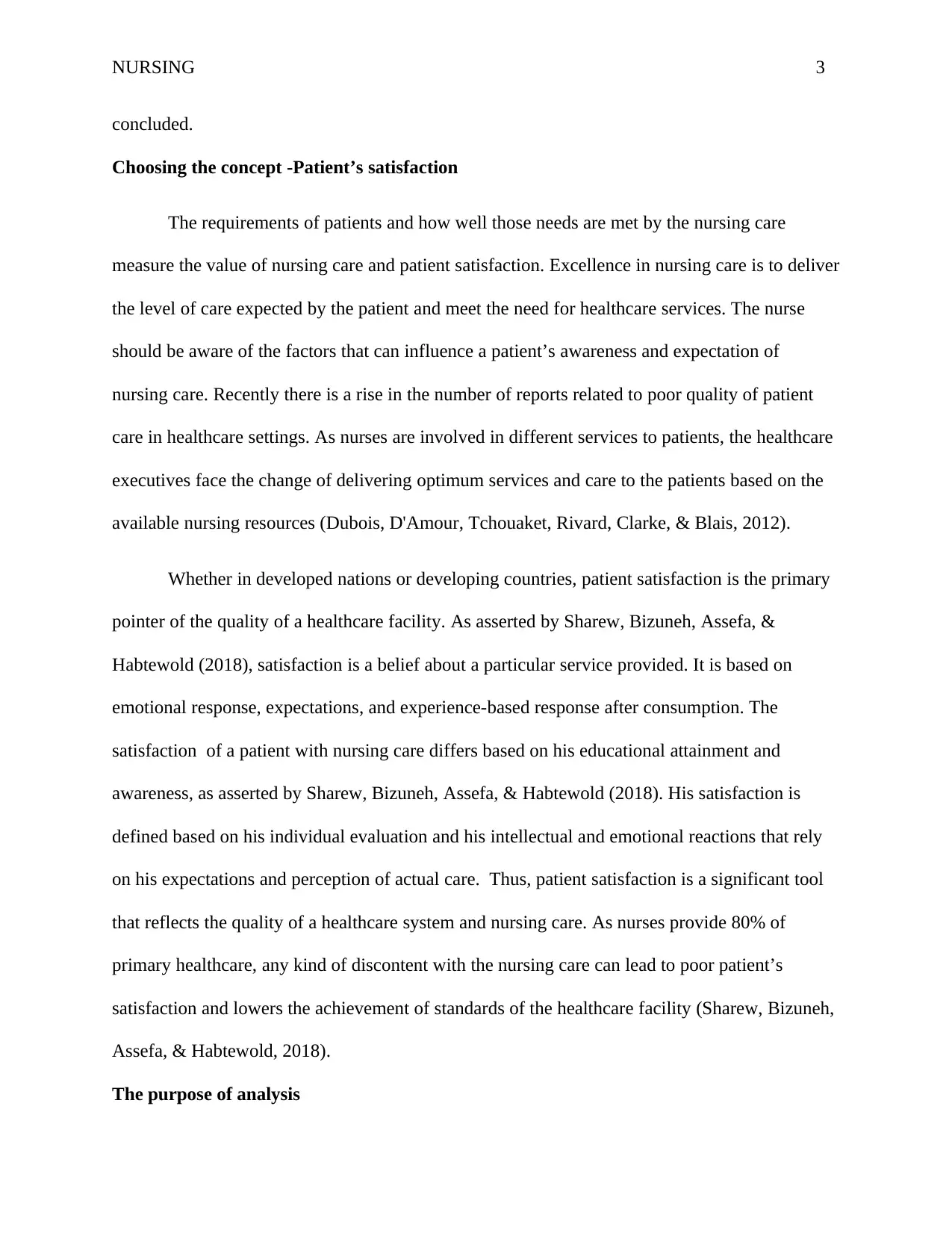
NURSING 3
concluded.
Choosing the concept -Patient’s satisfaction
The requirements of patients and how well those needs are met by the nursing care
measure the value of nursing care and patient satisfaction. Excellence in nursing care is to deliver
the level of care expected by the patient and meet the need for healthcare services. The nurse
should be aware of the factors that can influence a patient’s awareness and expectation of
nursing care. Recently there is a rise in the number of reports related to poor quality of patient
care in healthcare settings. As nurses are involved in different services to patients, the healthcare
executives face the change of delivering optimum services and care to the patients based on the
available nursing resources (Dubois, D'Amour, Tchouaket, Rivard, Clarke, & Blais, 2012).
Whether in developed nations or developing countries, patient satisfaction is the primary
pointer of the quality of a healthcare facility. As asserted by Sharew, Bizuneh, Assefa, &
Habtewold (2018), satisfaction is a belief about a particular service provided. It is based on
emotional response, expectations, and experience-based response after consumption. The
satisfaction of a patient with nursing care differs based on his educational attainment and
awareness, as asserted by Sharew, Bizuneh, Assefa, & Habtewold (2018). His satisfaction is
defined based on his individual evaluation and his intellectual and emotional reactions that rely
on his expectations and perception of actual care. Thus, patient satisfaction is a significant tool
that reflects the quality of a healthcare system and nursing care. As nurses provide 80% of
primary healthcare, any kind of discontent with the nursing care can lead to poor patient’s
satisfaction and lowers the achievement of standards of the healthcare facility (Sharew, Bizuneh,
Assefa, & Habtewold, 2018).
The purpose of analysis
concluded.
Choosing the concept -Patient’s satisfaction
The requirements of patients and how well those needs are met by the nursing care
measure the value of nursing care and patient satisfaction. Excellence in nursing care is to deliver
the level of care expected by the patient and meet the need for healthcare services. The nurse
should be aware of the factors that can influence a patient’s awareness and expectation of
nursing care. Recently there is a rise in the number of reports related to poor quality of patient
care in healthcare settings. As nurses are involved in different services to patients, the healthcare
executives face the change of delivering optimum services and care to the patients based on the
available nursing resources (Dubois, D'Amour, Tchouaket, Rivard, Clarke, & Blais, 2012).
Whether in developed nations or developing countries, patient satisfaction is the primary
pointer of the quality of a healthcare facility. As asserted by Sharew, Bizuneh, Assefa, &
Habtewold (2018), satisfaction is a belief about a particular service provided. It is based on
emotional response, expectations, and experience-based response after consumption. The
satisfaction of a patient with nursing care differs based on his educational attainment and
awareness, as asserted by Sharew, Bizuneh, Assefa, & Habtewold (2018). His satisfaction is
defined based on his individual evaluation and his intellectual and emotional reactions that rely
on his expectations and perception of actual care. Thus, patient satisfaction is a significant tool
that reflects the quality of a healthcare system and nursing care. As nurses provide 80% of
primary healthcare, any kind of discontent with the nursing care can lead to poor patient’s
satisfaction and lowers the achievement of standards of the healthcare facility (Sharew, Bizuneh,
Assefa, & Habtewold, 2018).
The purpose of analysis
⊘ This is a preview!⊘
Do you want full access?
Subscribe today to unlock all pages.

Trusted by 1+ million students worldwide

NURSING 4
The main objective of concept examination is to explain the sense of the concept of a
patient’s experience and satisfaction. It will contribute a better understanding of the significance
of a patient’s satisfaction when getting nursing care. The amount of time spent with the patient,
and the respect shown towards him determines the patient’s experience and satisfaction.
According to Girmay, Marye, Haftu, G/Her, Brhanu, Gerensea (2018), there are other factors
such as kindness, communication, and adequate information expected from nursing care. Many
researchers point out that as there is a gap between the actual expectation and perception of the
patients regarding nursing care, the image of nursing professionals becomes an ambiguous one.
The analysis will add to the shared understanding if health care and nursing and how to raise the
awareness of the components that work behind the concept of the patient’s satisfaction with
nursing care.
The use and significance of the concept
The third step in the examination of the patient’s experience and satisfaction allows a
better understanding of the concept and how it has been explored in the healthcare and nursing
literature. It is essential to evaluate and understand the patient’s satisfaction towards nursing care
as any negative feedback can impact the excellence of the entire health system as stated by
Girmay, Marye, Haftu , G/Her, Brhanu , Gerensea (2018). Understanding the patient’s
perceptions and how they look at the nursing care allows the health institutions to design a better
nursing care model and raise their reputation. It is essential to know why patients feel satisfied or
dissatisfied with different aspects of nursing care. Health institutions and nurses should focus on
the various factors associated with patients’ perception and how to raise his satisfaction.
Defining Attributes
The main objective of concept examination is to explain the sense of the concept of a
patient’s experience and satisfaction. It will contribute a better understanding of the significance
of a patient’s satisfaction when getting nursing care. The amount of time spent with the patient,
and the respect shown towards him determines the patient’s experience and satisfaction.
According to Girmay, Marye, Haftu, G/Her, Brhanu, Gerensea (2018), there are other factors
such as kindness, communication, and adequate information expected from nursing care. Many
researchers point out that as there is a gap between the actual expectation and perception of the
patients regarding nursing care, the image of nursing professionals becomes an ambiguous one.
The analysis will add to the shared understanding if health care and nursing and how to raise the
awareness of the components that work behind the concept of the patient’s satisfaction with
nursing care.
The use and significance of the concept
The third step in the examination of the patient’s experience and satisfaction allows a
better understanding of the concept and how it has been explored in the healthcare and nursing
literature. It is essential to evaluate and understand the patient’s satisfaction towards nursing care
as any negative feedback can impact the excellence of the entire health system as stated by
Girmay, Marye, Haftu , G/Her, Brhanu , Gerensea (2018). Understanding the patient’s
perceptions and how they look at the nursing care allows the health institutions to design a better
nursing care model and raise their reputation. It is essential to know why patients feel satisfied or
dissatisfied with different aspects of nursing care. Health institutions and nurses should focus on
the various factors associated with patients’ perception and how to raise his satisfaction.
Defining Attributes
Paraphrase This Document
Need a fresh take? Get an instant paraphrase of this document with our AI Paraphraser
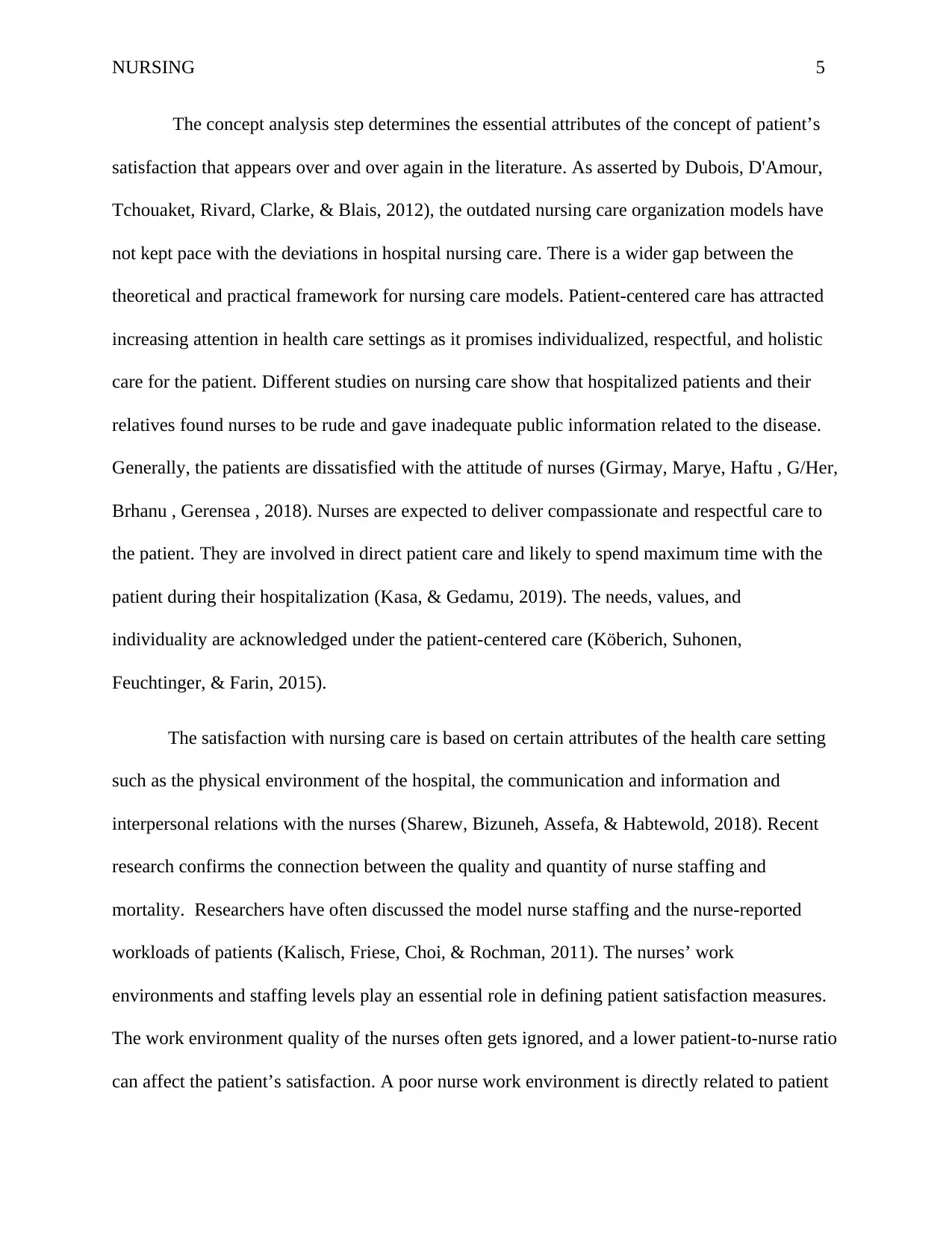
NURSING 5
The concept analysis step determines the essential attributes of the concept of patient’s
satisfaction that appears over and over again in the literature. As asserted by Dubois, D'Amour,
Tchouaket, Rivard, Clarke, & Blais, 2012), the outdated nursing care organization models have
not kept pace with the deviations in hospital nursing care. There is a wider gap between the
theoretical and practical framework for nursing care models. Patient-centered care has attracted
increasing attention in health care settings as it promises individualized, respectful, and holistic
care for the patient. Different studies on nursing care show that hospitalized patients and their
relatives found nurses to be rude and gave inadequate public information related to the disease.
Generally, the patients are dissatisfied with the attitude of nurses (Girmay, Marye, Haftu , G/Her,
Brhanu , Gerensea , 2018). Nurses are expected to deliver compassionate and respectful care to
the patient. They are involved in direct patient care and likely to spend maximum time with the
patient during their hospitalization (Kasa, & Gedamu, 2019). The needs, values, and
individuality are acknowledged under the patient-centered care (Köberich, Suhonen,
Feuchtinger, & Farin, 2015).
The satisfaction with nursing care is based on certain attributes of the health care setting
such as the physical environment of the hospital, the communication and information and
interpersonal relations with the nurses (Sharew, Bizuneh, Assefa, & Habtewold, 2018). Recent
research confirms the connection between the quality and quantity of nurse staffing and
mortality. Researchers have often discussed the model nurse staffing and the nurse-reported
workloads of patients (Kalisch, Friese, Choi, & Rochman, 2011). The nurses’ work
environments and staffing levels play an essential role in defining patient satisfaction measures.
The work environment quality of the nurses often gets ignored, and a lower patient-to-nurse ratio
can affect the patient’s satisfaction. A poor nurse work environment is directly related to patient
The concept analysis step determines the essential attributes of the concept of patient’s
satisfaction that appears over and over again in the literature. As asserted by Dubois, D'Amour,
Tchouaket, Rivard, Clarke, & Blais, 2012), the outdated nursing care organization models have
not kept pace with the deviations in hospital nursing care. There is a wider gap between the
theoretical and practical framework for nursing care models. Patient-centered care has attracted
increasing attention in health care settings as it promises individualized, respectful, and holistic
care for the patient. Different studies on nursing care show that hospitalized patients and their
relatives found nurses to be rude and gave inadequate public information related to the disease.
Generally, the patients are dissatisfied with the attitude of nurses (Girmay, Marye, Haftu , G/Her,
Brhanu , Gerensea , 2018). Nurses are expected to deliver compassionate and respectful care to
the patient. They are involved in direct patient care and likely to spend maximum time with the
patient during their hospitalization (Kasa, & Gedamu, 2019). The needs, values, and
individuality are acknowledged under the patient-centered care (Köberich, Suhonen,
Feuchtinger, & Farin, 2015).
The satisfaction with nursing care is based on certain attributes of the health care setting
such as the physical environment of the hospital, the communication and information and
interpersonal relations with the nurses (Sharew, Bizuneh, Assefa, & Habtewold, 2018). Recent
research confirms the connection between the quality and quantity of nurse staffing and
mortality. Researchers have often discussed the model nurse staffing and the nurse-reported
workloads of patients (Kalisch, Friese, Choi, & Rochman, 2011). The nurses’ work
environments and staffing levels play an essential role in defining patient satisfaction measures.
The work environment quality of the nurses often gets ignored, and a lower patient-to-nurse ratio
can affect the patient’s satisfaction. A poor nurse work environment is directly related to patient

NURSING 6
dissatisfaction and higher nurse turnover. In contrast, a better hospital work environments link to
higher job fulfilment and motivation among the nurses. Thus, a better nurse work environment in
hospitals can lead to higher patient satisfaction with his experiences (Kutney-Lee, McHugh,
Sloane, Cimiotti, Flynn, Neff, & Aiken, 2009).
The defining attributes of lower patient’s satisfaction rely on,
- the poor physical environment of the hospital
- inferior nurse to patient ratio
- inadequate working condition for the nurses
- the lower education level of the patient
- weak interpersonal relations with the nurses
Identifying a model case
During hospitalization, when the patient’s perception and expectation are met with, he
acknowledges a higher level of satisfaction. It is essential to measure the patient’s perceptions
and expectations that are connected to numerous social and professional facets of nursing care,
as asserted by Kasa, & Gedamu (2019). At the fifth step of the concept analysis of patient’s
perception, the building of a classical case makes a real-world extraction of the concept.
A model case of patient’s satisfaction can be presented here to discuss how a nurse
interacts with the patients. The hospital is noisy and congested and is not able to handle the load
of patients effectively. The nurses work in a stressed working environment and remain in a bad
temper most of the time. They understand their tasks of giving the best care, but because of the
heavier workload and poor nurse to patient ratio find it difficult to meet the objective of
dissatisfaction and higher nurse turnover. In contrast, a better hospital work environments link to
higher job fulfilment and motivation among the nurses. Thus, a better nurse work environment in
hospitals can lead to higher patient satisfaction with his experiences (Kutney-Lee, McHugh,
Sloane, Cimiotti, Flynn, Neff, & Aiken, 2009).
The defining attributes of lower patient’s satisfaction rely on,
- the poor physical environment of the hospital
- inferior nurse to patient ratio
- inadequate working condition for the nurses
- the lower education level of the patient
- weak interpersonal relations with the nurses
Identifying a model case
During hospitalization, when the patient’s perception and expectation are met with, he
acknowledges a higher level of satisfaction. It is essential to measure the patient’s perceptions
and expectations that are connected to numerous social and professional facets of nursing care,
as asserted by Kasa, & Gedamu (2019). At the fifth step of the concept analysis of patient’s
perception, the building of a classical case makes a real-world extraction of the concept.
A model case of patient’s satisfaction can be presented here to discuss how a nurse
interacts with the patients. The hospital is noisy and congested and is not able to handle the load
of patients effectively. The nurses work in a stressed working environment and remain in a bad
temper most of the time. They understand their tasks of giving the best care, but because of the
heavier workload and poor nurse to patient ratio find it difficult to meet the objective of
⊘ This is a preview!⊘
Do you want full access?
Subscribe today to unlock all pages.

Trusted by 1+ million students worldwide
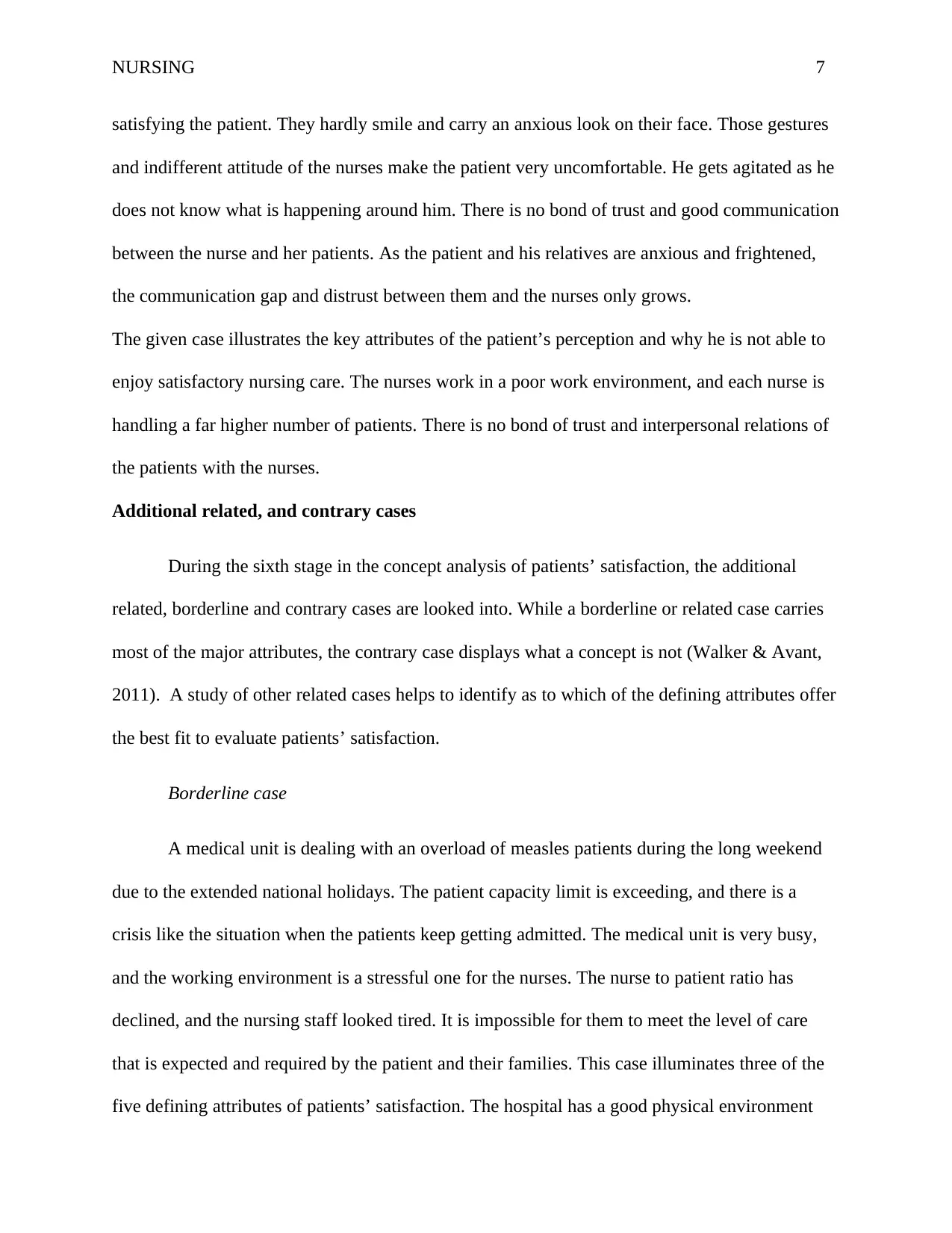
NURSING 7
satisfying the patient. They hardly smile and carry an anxious look on their face. Those gestures
and indifferent attitude of the nurses make the patient very uncomfortable. He gets agitated as he
does not know what is happening around him. There is no bond of trust and good communication
between the nurse and her patients. As the patient and his relatives are anxious and frightened,
the communication gap and distrust between them and the nurses only grows.
The given case illustrates the key attributes of the patient’s perception and why he is not able to
enjoy satisfactory nursing care. The nurses work in a poor work environment, and each nurse is
handling a far higher number of patients. There is no bond of trust and interpersonal relations of
the patients with the nurses.
Additional related, and contrary cases
During the sixth stage in the concept analysis of patients’ satisfaction, the additional
related, borderline and contrary cases are looked into. While a borderline or related case carries
most of the major attributes, the contrary case displays what a concept is not (Walker & Avant,
2011). A study of other related cases helps to identify as to which of the defining attributes offer
the best fit to evaluate patients’ satisfaction.
Borderline case
A medical unit is dealing with an overload of measles patients during the long weekend
due to the extended national holidays. The patient capacity limit is exceeding, and there is a
crisis like the situation when the patients keep getting admitted. The medical unit is very busy,
and the working environment is a stressful one for the nurses. The nurse to patient ratio has
declined, and the nursing staff looked tired. It is impossible for them to meet the level of care
that is expected and required by the patient and their families. This case illuminates three of the
five defining attributes of patients’ satisfaction. The hospital has a good physical environment
satisfying the patient. They hardly smile and carry an anxious look on their face. Those gestures
and indifferent attitude of the nurses make the patient very uncomfortable. He gets agitated as he
does not know what is happening around him. There is no bond of trust and good communication
between the nurse and her patients. As the patient and his relatives are anxious and frightened,
the communication gap and distrust between them and the nurses only grows.
The given case illustrates the key attributes of the patient’s perception and why he is not able to
enjoy satisfactory nursing care. The nurses work in a poor work environment, and each nurse is
handling a far higher number of patients. There is no bond of trust and interpersonal relations of
the patients with the nurses.
Additional related, and contrary cases
During the sixth stage in the concept analysis of patients’ satisfaction, the additional
related, borderline and contrary cases are looked into. While a borderline or related case carries
most of the major attributes, the contrary case displays what a concept is not (Walker & Avant,
2011). A study of other related cases helps to identify as to which of the defining attributes offer
the best fit to evaluate patients’ satisfaction.
Borderline case
A medical unit is dealing with an overload of measles patients during the long weekend
due to the extended national holidays. The patient capacity limit is exceeding, and there is a
crisis like the situation when the patients keep getting admitted. The medical unit is very busy,
and the working environment is a stressful one for the nurses. The nurse to patient ratio has
declined, and the nursing staff looked tired. It is impossible for them to meet the level of care
that is expected and required by the patient and their families. This case illuminates three of the
five defining attributes of patients’ satisfaction. The hospital has a good physical environment
Paraphrase This Document
Need a fresh take? Get an instant paraphrase of this document with our AI Paraphraser
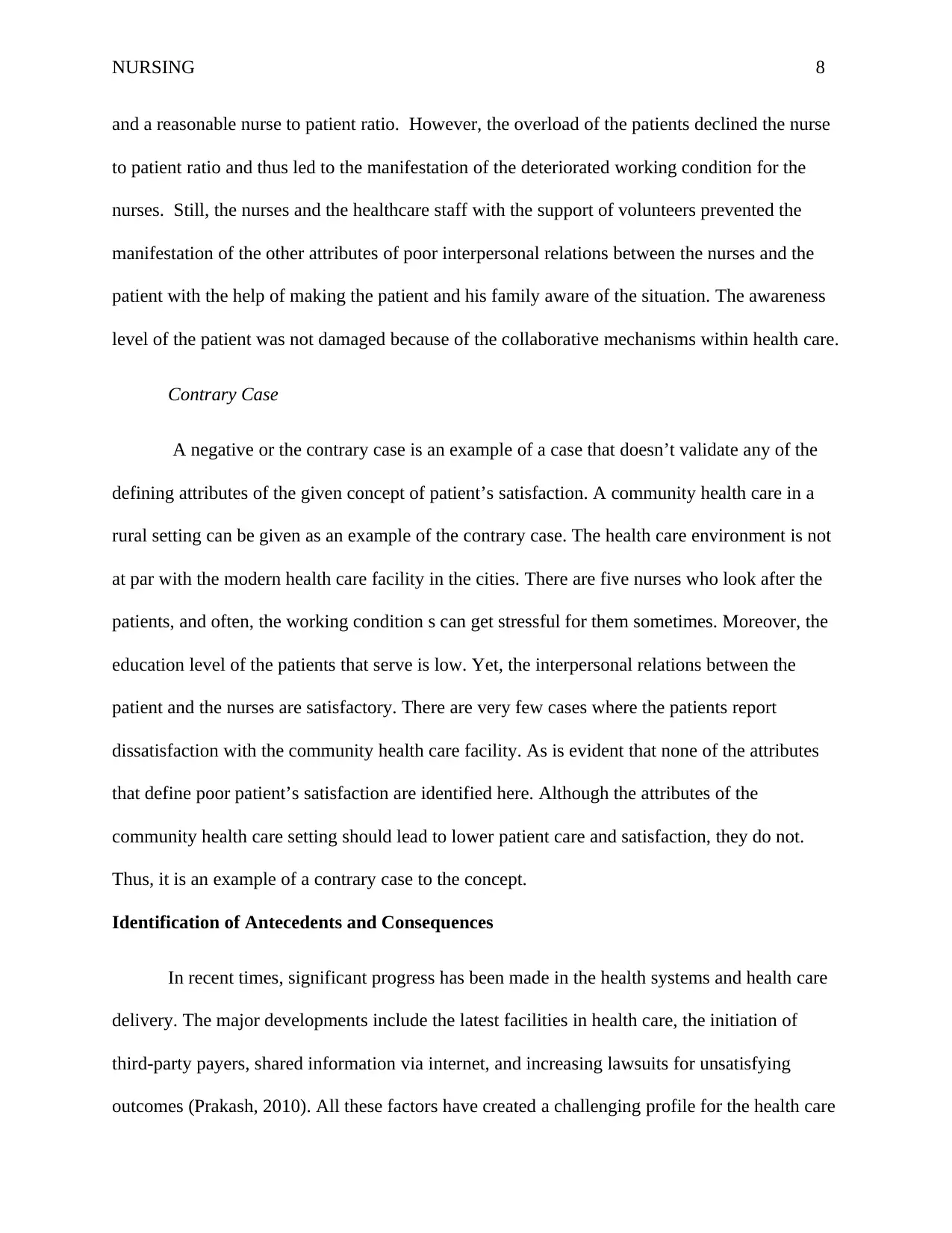
NURSING 8
and a reasonable nurse to patient ratio. However, the overload of the patients declined the nurse
to patient ratio and thus led to the manifestation of the deteriorated working condition for the
nurses. Still, the nurses and the healthcare staff with the support of volunteers prevented the
manifestation of the other attributes of poor interpersonal relations between the nurses and the
patient with the help of making the patient and his family aware of the situation. The awareness
level of the patient was not damaged because of the collaborative mechanisms within health care.
Contrary Case
A negative or the contrary case is an example of a case that doesn’t validate any of the
defining attributes of the given concept of patient’s satisfaction. A community health care in a
rural setting can be given as an example of the contrary case. The health care environment is not
at par with the modern health care facility in the cities. There are five nurses who look after the
patients, and often, the working condition s can get stressful for them sometimes. Moreover, the
education level of the patients that serve is low. Yet, the interpersonal relations between the
patient and the nurses are satisfactory. There are very few cases where the patients report
dissatisfaction with the community health care facility. As is evident that none of the attributes
that define poor patient’s satisfaction are identified here. Although the attributes of the
community health care setting should lead to lower patient care and satisfaction, they do not.
Thus, it is an example of a contrary case to the concept.
Identification of Antecedents and Consequences
In recent times, significant progress has been made in the health systems and health care
delivery. The major developments include the latest facilities in health care, the initiation of
third-party payers, shared information via internet, and increasing lawsuits for unsatisfying
outcomes (Prakash, 2010). All these factors have created a challenging profile for the health care
and a reasonable nurse to patient ratio. However, the overload of the patients declined the nurse
to patient ratio and thus led to the manifestation of the deteriorated working condition for the
nurses. Still, the nurses and the healthcare staff with the support of volunteers prevented the
manifestation of the other attributes of poor interpersonal relations between the nurses and the
patient with the help of making the patient and his family aware of the situation. The awareness
level of the patient was not damaged because of the collaborative mechanisms within health care.
Contrary Case
A negative or the contrary case is an example of a case that doesn’t validate any of the
defining attributes of the given concept of patient’s satisfaction. A community health care in a
rural setting can be given as an example of the contrary case. The health care environment is not
at par with the modern health care facility in the cities. There are five nurses who look after the
patients, and often, the working condition s can get stressful for them sometimes. Moreover, the
education level of the patients that serve is low. Yet, the interpersonal relations between the
patient and the nurses are satisfactory. There are very few cases where the patients report
dissatisfaction with the community health care facility. As is evident that none of the attributes
that define poor patient’s satisfaction are identified here. Although the attributes of the
community health care setting should lead to lower patient care and satisfaction, they do not.
Thus, it is an example of a contrary case to the concept.
Identification of Antecedents and Consequences
In recent times, significant progress has been made in the health systems and health care
delivery. The major developments include the latest facilities in health care, the initiation of
third-party payers, shared information via internet, and increasing lawsuits for unsatisfying
outcomes (Prakash, 2010). All these factors have created a challenging profile for the health care

NURSING 9
industry. The seventh stage in the concept analysis is to locate the antecedents and consequences.
Antecedents occur prior to the concept of manifestation, while events occur as a result of the
concept.
The key antecedents to patient’s satisfaction include a stressful work environment for the
nursing staff, poor nurse to patient ratio, and weaker interpersonal relation. Those are the main
factors that can lead to a lower perception and satisfaction among the patient regarding nursing
care in a certain health care facility.
The consequences of lower perception and satisfaction among the patient are poor patient
retention, damaged reputation of the health care facility, and lower profitability due to
dissatisfaction among the patients. It can further lead to lower staff morale with higher staff
turnover. Patient satisfaction is crucial as it builds customer loyalty, as asserted by Prakash
(2010). There is adequate indication that patients are willing to pay more for quality services,
and hospitals with high customer loyalty can ask for a higher price.
Defining Empirical Referents
The final stage in the concept analysis based on Walker & Avant’s approach relates to the
identification of the observed referents. The empirical referents establish the presence of the
concept in its related context. These are useful practically because they offer the method as to
how the concept can be observed and studied. The literature on patient’s satisfaction on nursing
care proposes a multidimensional tactic to the phenomenon.
To advance patient satisfaction, hospitals should work on their physical environment and
the setting in which patients receive care. Hospital environment should take into consideration
industry. The seventh stage in the concept analysis is to locate the antecedents and consequences.
Antecedents occur prior to the concept of manifestation, while events occur as a result of the
concept.
The key antecedents to patient’s satisfaction include a stressful work environment for the
nursing staff, poor nurse to patient ratio, and weaker interpersonal relation. Those are the main
factors that can lead to a lower perception and satisfaction among the patient regarding nursing
care in a certain health care facility.
The consequences of lower perception and satisfaction among the patient are poor patient
retention, damaged reputation of the health care facility, and lower profitability due to
dissatisfaction among the patients. It can further lead to lower staff morale with higher staff
turnover. Patient satisfaction is crucial as it builds customer loyalty, as asserted by Prakash
(2010). There is adequate indication that patients are willing to pay more for quality services,
and hospitals with high customer loyalty can ask for a higher price.
Defining Empirical Referents
The final stage in the concept analysis based on Walker & Avant’s approach relates to the
identification of the observed referents. The empirical referents establish the presence of the
concept in its related context. These are useful practically because they offer the method as to
how the concept can be observed and studied. The literature on patient’s satisfaction on nursing
care proposes a multidimensional tactic to the phenomenon.
To advance patient satisfaction, hospitals should work on their physical environment and
the setting in which patients receive care. Hospital environment should take into consideration
⊘ This is a preview!⊘
Do you want full access?
Subscribe today to unlock all pages.

Trusted by 1+ million students worldwide
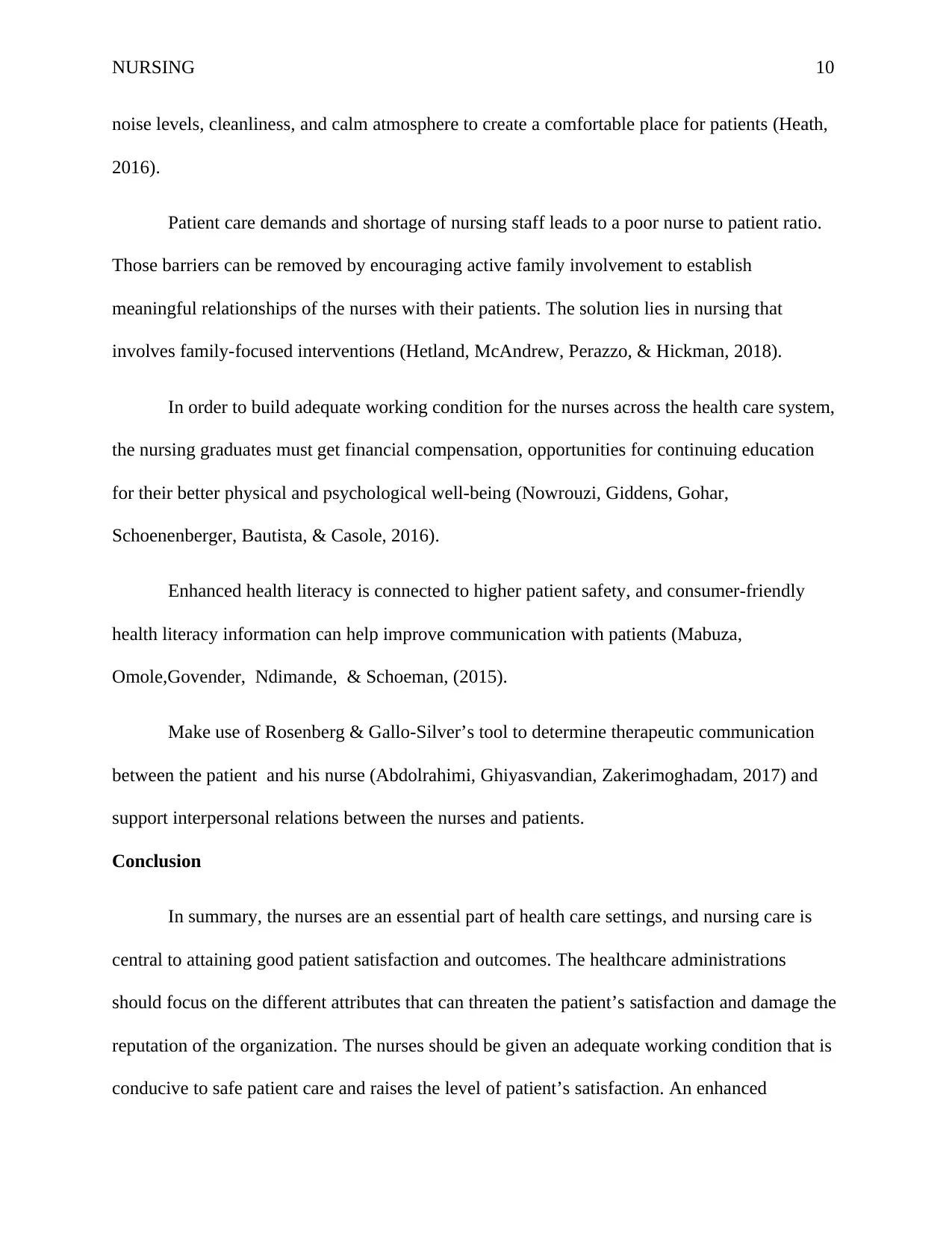
NURSING 10
noise levels, cleanliness, and calm atmosphere to create a comfortable place for patients (Heath,
2016).
Patient care demands and shortage of nursing staff leads to a poor nurse to patient ratio.
Those barriers can be removed by encouraging active family involvement to establish
meaningful relationships of the nurses with their patients. The solution lies in nursing that
involves family-focused interventions (Hetland, McAndrew, Perazzo, & Hickman, 2018).
In order to build adequate working condition for the nurses across the health care system,
the nursing graduates must get financial compensation, opportunities for continuing education
for their better physical and psychological well-being (Nowrouzi, Giddens, Gohar,
Schoenenberger, Bautista, & Casole, 2016).
Enhanced health literacy is connected to higher patient safety, and consumer-friendly
health literacy information can help improve communication with patients (Mabuza,
Omole,Govender, Ndimande, & Schoeman, (2015).
Make use of Rosenberg & Gallo-Silver’s tool to determine therapeutic communication
between the patient and his nurse (Abdolrahimi, Ghiyasvandian, Zakerimoghadam, 2017) and
support interpersonal relations between the nurses and patients.
Conclusion
In summary, the nurses are an essential part of health care settings, and nursing care is
central to attaining good patient satisfaction and outcomes. The healthcare administrations
should focus on the different attributes that can threaten the patient’s satisfaction and damage the
reputation of the organization. The nurses should be given an adequate working condition that is
conducive to safe patient care and raises the level of patient’s satisfaction. An enhanced
noise levels, cleanliness, and calm atmosphere to create a comfortable place for patients (Heath,
2016).
Patient care demands and shortage of nursing staff leads to a poor nurse to patient ratio.
Those barriers can be removed by encouraging active family involvement to establish
meaningful relationships of the nurses with their patients. The solution lies in nursing that
involves family-focused interventions (Hetland, McAndrew, Perazzo, & Hickman, 2018).
In order to build adequate working condition for the nurses across the health care system,
the nursing graduates must get financial compensation, opportunities for continuing education
for their better physical and psychological well-being (Nowrouzi, Giddens, Gohar,
Schoenenberger, Bautista, & Casole, 2016).
Enhanced health literacy is connected to higher patient safety, and consumer-friendly
health literacy information can help improve communication with patients (Mabuza,
Omole,Govender, Ndimande, & Schoeman, (2015).
Make use of Rosenberg & Gallo-Silver’s tool to determine therapeutic communication
between the patient and his nurse (Abdolrahimi, Ghiyasvandian, Zakerimoghadam, 2017) and
support interpersonal relations between the nurses and patients.
Conclusion
In summary, the nurses are an essential part of health care settings, and nursing care is
central to attaining good patient satisfaction and outcomes. The healthcare administrations
should focus on the different attributes that can threaten the patient’s satisfaction and damage the
reputation of the organization. The nurses should be given an adequate working condition that is
conducive to safe patient care and raises the level of patient’s satisfaction. An enhanced
Paraphrase This Document
Need a fresh take? Get an instant paraphrase of this document with our AI Paraphraser
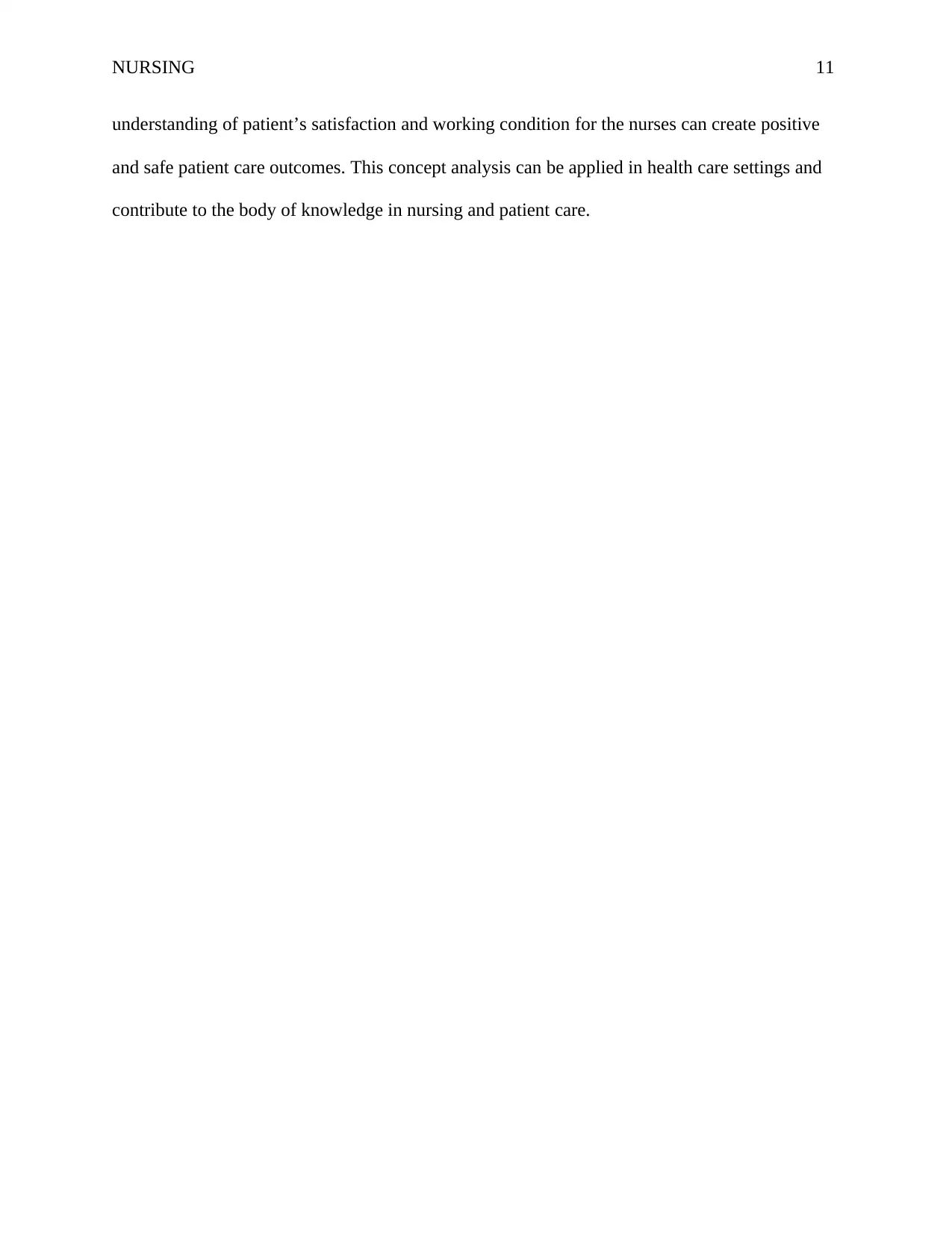
NURSING 11
understanding of patient’s satisfaction and working condition for the nurses can create positive
and safe patient care outcomes. This concept analysis can be applied in health care settings and
contribute to the body of knowledge in nursing and patient care.
understanding of patient’s satisfaction and working condition for the nurses can create positive
and safe patient care outcomes. This concept analysis can be applied in health care settings and
contribute to the body of knowledge in nursing and patient care.
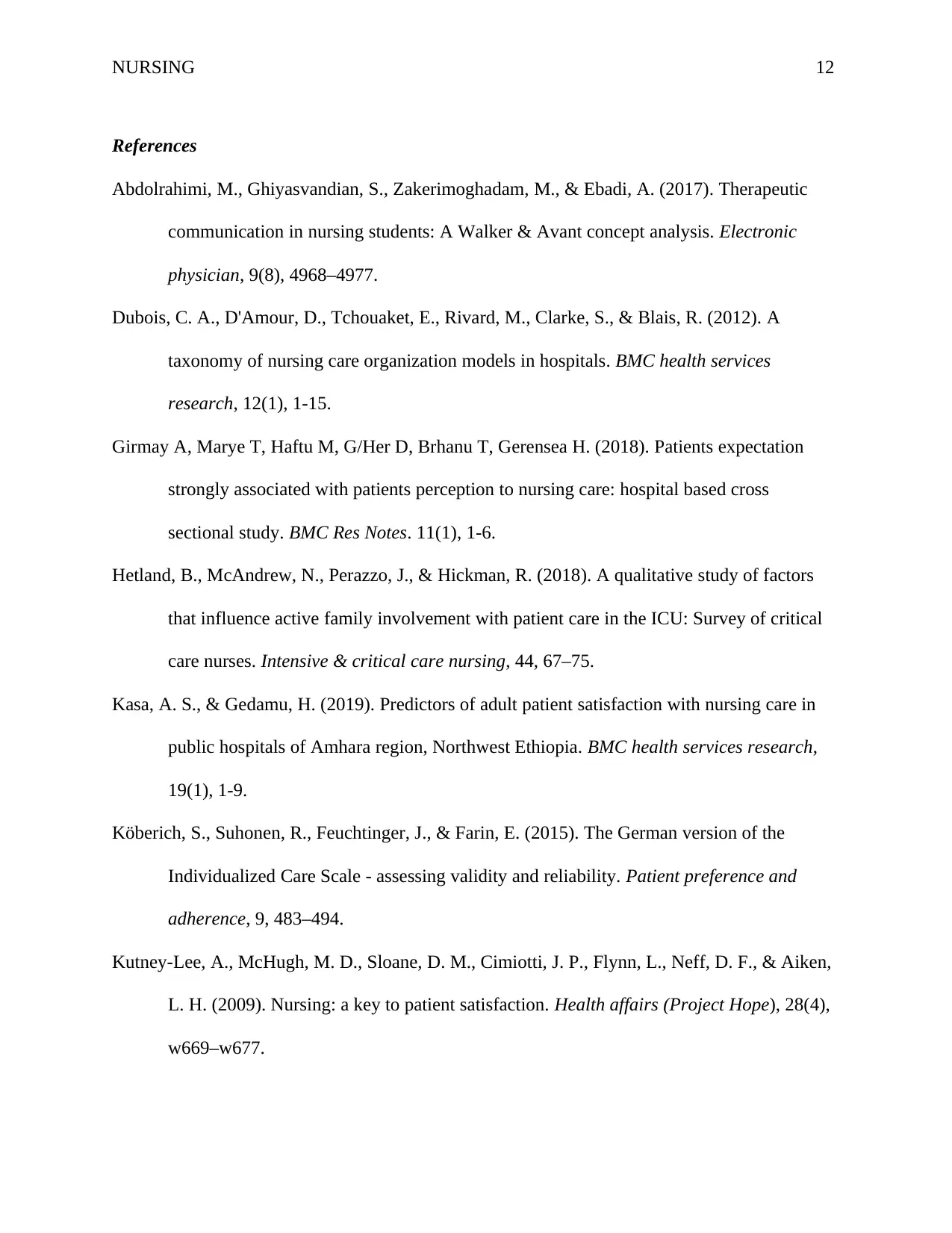
NURSING 12
References
Abdolrahimi, M., Ghiyasvandian, S., Zakerimoghadam, M., & Ebadi, A. (2017). Therapeutic
communication in nursing students: A Walker & Avant concept analysis. Electronic
physician, 9(8), 4968–4977.
Dubois, C. A., D'Amour, D., Tchouaket, E., Rivard, M., Clarke, S., & Blais, R. (2012). A
taxonomy of nursing care organization models in hospitals. BMC health services
research, 12(1), 1-15.
Girmay A, Marye T, Haftu M, G/Her D, Brhanu T, Gerensea H. (2018). Patients expectation
strongly associated with patients perception to nursing care: hospital based cross
sectional study. BMC Res Notes. 11(1), 1-6.
Hetland, B., McAndrew, N., Perazzo, J., & Hickman, R. (2018). A qualitative study of factors
that influence active family involvement with patient care in the ICU: Survey of critical
care nurses. Intensive & critical care nursing, 44, 67–75.
Kasa, A. S., & Gedamu, H. (2019). Predictors of adult patient satisfaction with nursing care in
public hospitals of Amhara region, Northwest Ethiopia. BMC health services research,
19(1), 1-9.
Köberich, S., Suhonen, R., Feuchtinger, J., & Farin, E. (2015). The German version of the
Individualized Care Scale - assessing validity and reliability. Patient preference and
adherence, 9, 483–494.
Kutney-Lee, A., McHugh, M. D., Sloane, D. M., Cimiotti, J. P., Flynn, L., Neff, D. F., & Aiken,
L. H. (2009). Nursing: a key to patient satisfaction. Health affairs (Project Hope), 28(4),
w669–w677.
References
Abdolrahimi, M., Ghiyasvandian, S., Zakerimoghadam, M., & Ebadi, A. (2017). Therapeutic
communication in nursing students: A Walker & Avant concept analysis. Electronic
physician, 9(8), 4968–4977.
Dubois, C. A., D'Amour, D., Tchouaket, E., Rivard, M., Clarke, S., & Blais, R. (2012). A
taxonomy of nursing care organization models in hospitals. BMC health services
research, 12(1), 1-15.
Girmay A, Marye T, Haftu M, G/Her D, Brhanu T, Gerensea H. (2018). Patients expectation
strongly associated with patients perception to nursing care: hospital based cross
sectional study. BMC Res Notes. 11(1), 1-6.
Hetland, B., McAndrew, N., Perazzo, J., & Hickman, R. (2018). A qualitative study of factors
that influence active family involvement with patient care in the ICU: Survey of critical
care nurses. Intensive & critical care nursing, 44, 67–75.
Kasa, A. S., & Gedamu, H. (2019). Predictors of adult patient satisfaction with nursing care in
public hospitals of Amhara region, Northwest Ethiopia. BMC health services research,
19(1), 1-9.
Köberich, S., Suhonen, R., Feuchtinger, J., & Farin, E. (2015). The German version of the
Individualized Care Scale - assessing validity and reliability. Patient preference and
adherence, 9, 483–494.
Kutney-Lee, A., McHugh, M. D., Sloane, D. M., Cimiotti, J. P., Flynn, L., Neff, D. F., & Aiken,
L. H. (2009). Nursing: a key to patient satisfaction. Health affairs (Project Hope), 28(4),
w669–w677.
⊘ This is a preview!⊘
Do you want full access?
Subscribe today to unlock all pages.

Trusted by 1+ million students worldwide
1 out of 13
Related Documents
Your All-in-One AI-Powered Toolkit for Academic Success.
+13062052269
info@desklib.com
Available 24*7 on WhatsApp / Email
![[object Object]](/_next/static/media/star-bottom.7253800d.svg)
Unlock your academic potential
Copyright © 2020–2025 A2Z Services. All Rights Reserved. Developed and managed by ZUCOL.





